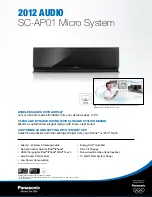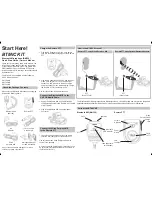
GE Multilin
L60 Line Phase Comparison System
5-293
5 SETTINGS
5.6 CONTROL ELEMENTS
5
FORCE 3-POLE TRIPPING:
The reclosing scheme contains logic that is used to signal trip logic that three-pole tripping is required for certain conditions.
This signal is activated by any of the following:
•
Autoreclose scheme is paused after it was initiated.
•
Autoreclose scheme is in the lockout state.
•
Autoreclose mode is programmed for three-pole operation
•
The shot counter is not at 0; that is, the scheme is not in the reset state. This ensures a second trip will be three-pole
when reclosing onto a permanent single phase fault.
•
1.25 cycles after the single-pole reclose is initiated by the
AR 1P INIT
signal.
ZONE 1 EXTENT:
The zone 1 extension philosophy here is to apply an overreaching zone permanently as long as the relay is ready to
reclose, and reduce the reach when reclosing. Another zone 1 extension approach is to operate normally from an under-
reaching zone, and use an overreaching distance zone when reclosing the line with the other line end open. This philoso-
phy could be programmed via the line pickup scheme.
The “Extended Zone 1" is 0 when autoreclose is in lockout or disabled and 1 when autoreclose is in reset.
1.
When "Extended Zone 1" is 0, the distance functions shall be set to normal underreach Zone 1 setting.
2.
When "Extended Zone 1" is 1, the distance functions may be set to Extended Zone 1 Reach, which is an overreaching
setting.
3.
During a reclose cycle, "Extended Zone 1" goes to 0 as soon as the first
CLOSE BREAKER
signal is issued (
AR SHOT
COUNT > 0
) and remains 0 until the recloser goes back to reset.
USE OF SETTINGS:
The single-phase autoreclose settings are described here.
•
AR MODE
: This setting selects the Autoreclose operating mode from the four available reclose modes (Mode 1: 1 & 3
Pole, Mode 2: 1 Pole, Mode 3: 3 Pole-A and Mode 4: 3 Pole-B), which functions in conjunction with signals received at
the initiation inputs as described previously. The autorecloser runs in this mode until a different mode is activated
through the AR Mode Activation inputs explained as follows.
•
MODE 1 to MODE 4 ACTIVATION
: This setting selects an operand for activating the corresponding AR mode in run-
time. Mode change via activation input takes place when only one of the four activation inputs is high and the AR RIP
operand is low (that is, reclose is not in progress) and also the mode to be activated is different from the existing mode,
otherwise the activation input is ignored and the existing mode continues to be used. See details in the Mode Control
Logic diagram.
•
AR MAX NUMBER OF SHOTS
: This setting specifies the number of reclosures that can be attempted before reclo-
sure goes to lockout when the fault is permanent.
•
AR INITIATE MODE
: This setting selects the autoreclose initiation mode. When selected as “Protection AND CB”, the
autoreclose element is initiated by protection operation and begins incrementing the autoreclose dead time timer when
a circuit breaker is open. Breaker status is determined from breaker auxiliary contacts which should be correctly config-
ured in breaker settings. In “Protection only” initiation mode, the autoreclose element is initiated by protection opera-
tion and begins incrementing the dead time when protection resets, without the need of breaker auxiliary contacts.
•
AR BLOCK BKR1
: This input selects an operand that will block the reclose command for breaker 1. This condition can
be for example: breaker low air pressure, reclose in progress on another line (for the central breaker in a breaker and
a half arrangement), or a sum of conditions combined in FlexLogic.
•
AR CLOSE TIME BKR1
:This setting represents the closing time for the breaker 1 from the moment the “Close” com-
mand is sent to the moment the contacts are closed.
•
AR BKR MAN CLOSE:
This setting selects a FlexLogic operand that represents manual close command to a breaker
associated with the autoreclose scheme.
•
AR BLK TIME UPON MAN CLS
: The autoreclose scheme can be disabled for a programmable time delay after an
associated circuit breaker is manually commanded to close, preventing reclosing onto an existing fault such as
grounds on the line. This delay must be longer than the slowest expected trip from any protection not blocked after
Summary of Contents for L60
Page 10: ...x L60 Line Phase Comparison System GE Multilin TABLE OF CONTENTS ...
Page 57: ...GE Multilin L60 Line Phase Comparison System 2 27 2 PRODUCT DESCRIPTION 2 3 SPECIFICATIONS 2 ...
Page 58: ...2 28 L60 Line Phase Comparison System GE Multilin 2 3 SPECIFICATIONS 2 PRODUCT DESCRIPTION 2 ...
Page 482: ...6 26 L60 Line Phase Comparison System GE Multilin 6 5 PRODUCT INFORMATION 6 ACTUAL VALUES 6 ...
Page 554: ...10 8 L60 Line Phase Comparison System GE Multilin 10 2 BATTERIES 10 MAINTENANCE 10 ...
Page 674: ...B 110 L60 Line Phase Comparison System GE Multilin B 4 MEMORY MAPPING APPENDIX B B ...
Page 704: ...C 30 L60 Line Phase Comparison System GE Multilin C 7 LOGICAL NODES APPENDIX C C ...
Page 720: ...E 10 L60 Line Phase Comparison System GE Multilin E 1 PROTOCOL APPENDIX E E ...
Page 732: ...F 12 L60 Line Phase Comparison System GE Multilin F 2 DNP POINT LISTS APPENDIX F F ...
Page 742: ...H 8 L60 Line Phase Comparison System GE Multilin H 3 WARRANTY APPENDIX H H ...
















































